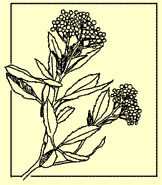These lizards like to bury themselves in sandy places such as the washes at the BFS, and often are found under rocks. They can be found as deep as 18 inches but are usually nearer the surface. They produce an extensive system of burrows which may help to aerate the soil and improve drainage. They spend quite a bit of time feeding on insects where the sandy soil meets the leaf litter under shrubs. Anniella feeds on beetle larvae, adult beetles, insect pupae, spiders, sow bugs, ants, and termites.
Legless lizards produce up to three live offspring a year. They can live up to 8 years in the lab but in the wild they are frequently prey to hawks, owls, and coyotes, and to cats and dogs as well as to people , since the largest populations live in coastal dune areas. Legless lizards are a California Species of Special Concern.
A Season of berries
by Mark F. Acuña, Gabrieleno-Tongva
We can celebrate the cold times of "Achocheva" as did the Tongva in their villages throughout the greater Los Angeles Basin when they withdrew into their homes and told stories to their children. It was the great season of mending and learning. It was a time of family withdrawal from the outer world into the spiritual world of "Coyote Tale" time. In spring the world, "Paratsotson", would renew itself and the people would celebrate. But now in the cold times, in the months of "Whistling Wind" and "Cold and Last Hunts" the people rejoiced in the harvesting of the red berries of Toyon. Toyon berries brightened the cold dark days of winter for the Tongva as they do for those who pass by the entrance to the BFS.
Toyon is known by botanists as Heteromeles arbutifolia. Californians call it Toyon, Christmas Berry, California Berry, or Holly Berry (giving Hollywood its name). The Tongva called it Ashuwet. This wondrous shrub gave them food, medicine, tools, a dye, and hair ornaments.
The bark and the leaves were made into a tea for stomach pains, produced a seasonal tonic and an wash for infected wounds. Mashed leaves were applied to sores. Flowers were pulverized and steeped to make a medicinal tea which the women drank. The berries produced a dye, as did the bark which was used to dye fish nets. The berries were eaten fresh, roasted, or boiled and baked. Fresh berries made a refreshing cider. Wood was turned into fine arrows, awls, wedges, scrapers, spoons, mashers, and stirrers, and hair sticks decorated with Flicker feathers for the men.
>>Alert! Claremont Wildlife Poisoned!<<
In recent months a Cooper's hawk and two great horned owls have died from poisoning by the anti-coagulant rodenticide brodifacoum near the Bernard Field Station. Two other owls and four coyotes may also have been poisoned. These cases are "secondary poisoning"; the raptors died from eating rodents that had consumed poison but not yet died. In both California and New York, brodifacoum accounts for about 80% of the secondary poisonings by rodenticides.
In California brodifacoum may be used to control Norway rats, roof rats, and house mice in residential, industrial, commercial, agricultural, and public buildings. It is the active ingredient in over-the-counter rat and mouse poisons available in grocery and hardware stores. Both the California Department of Pesticide Regulation and the EPA are reevaluating the regulatory status of brodifacoum, but change will take at least a year.
What you can do:If you find dead wild animals or rodent bait stations, please call or e-mail Nancy Hamlett: 909-625-2223 (home), 909-607-3811 (work), or Nancy.Hamlett@Pomona.edu.
Educate others about the danger of secondary poisoning of wildlife.
Choose safer methods for rodent control. San Gabriel Valley Mosquito and Vector Control will consult on rodent problems. Call (626) 814-9466 or e-mail district@sgvmosquito.org.
For more information, see http://www.fbbfs.org/poisoning.html
Broad Center at Pitzer This will be a chance for you to ask questions about what is happening and what is likely to happen and to help plan the future. Please make every effort to come! |
$$$$ Recycling$$$$
Valerie Gustaveson has volunteered to oversee recycling as a fund-raiser for the Friends. You may drop off glass, plastic, and aluminum with redemption value at her house. Call her at 621- 1273 for directions. Thanks, Valerie!